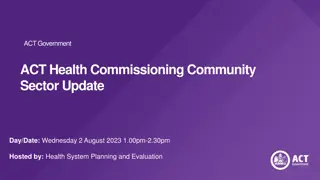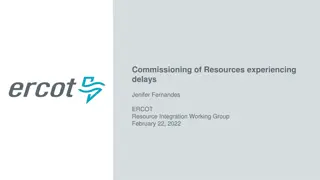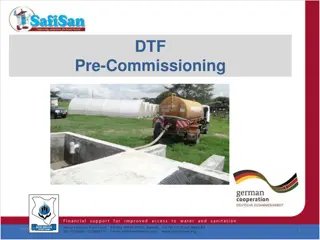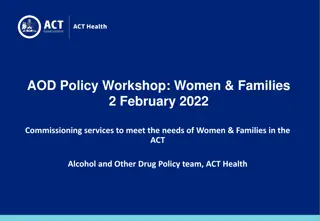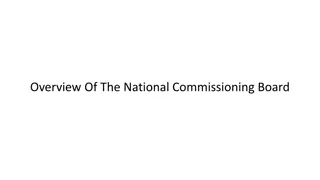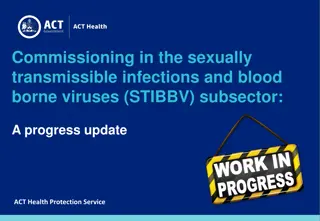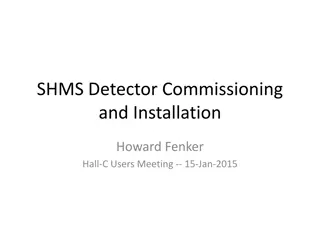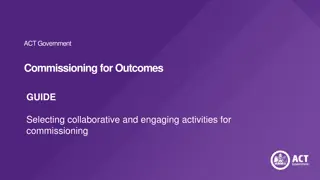Commissioning Progress & Outcomes in STIBBV Subsector
In this discussion, progress and outcomes in the sexually transmissible infections and blood-borne viruses subsector are recapped. Priority areas for improvement, care considerations, and strategies to address STIs are outlined, with a focus on health literacy, screening, outreach programs, and reducing stigma.
Download Presentation

Please find below an Image/Link to download the presentation.
The content on the website is provided AS IS for your information and personal use only. It may not be sold, licensed, or shared on other websites without obtaining consent from the author.If you encounter any issues during the download, it is possible that the publisher has removed the file from their server.
You are allowed to download the files provided on this website for personal or commercial use, subject to the condition that they are used lawfully. All files are the property of their respective owners.
The content on the website is provided AS IS for your information and personal use only. It may not be sold, licensed, or shared on other websites without obtaining consent from the author.
E N D
Presentation Transcript
Commissioning in the sexually transmissible infections and blood borne viruses subsector Progress recap and outcomes discussion Fellon Gaida on behalf of Public Health Regulation and Projects December 2022
We acknowledge the Ngunnawal people, traditional We acknowledge the Ngunnawal people, traditional custodians of this beautiful Country we have the privilege to custodians of this beautiful Country we have the privilege to call home. We pay our respects to their Elders, past and call home. We pay our respects to their Elders, past and present, and the contribution they make to the life of this present, and the contribution they make to the life of this city and to its success. city and to its success. 2
Session objective 1. Recap progress, priorities and care considerations as identified thus far through the commissioning process 2. Revisit outcomes and the interplay with commissioning 3. Explore what level of outcomes reporting would work best within the STIBBV subsector 4. Revisit and further brainstorm high, medium and lower level outcomes for consideration 3
Sexually transmissible infections Priority to be addressed through commissioning Service/care/programmatic considerations Improve health literacy related to STIs, with a particular focus on young people, CALD communities, women and other people with a cervix/uterus of reproductive health age, gay, bisexual and other men who have sex with men, and First Nations people Increase screening for: chlamydia gonorrhoea infectious syphilis Health promotion/education campaigns and targeted programs which seek to increase health literacy amongst priority groups and the wider ACT population. Outreach engagements which capture priority groups (e.g small groups facilitated within migrants support services etc). Education programs which explore STIs in the context of consent, sexual safety and autonomy, relationships etc. Youth-focused initiatives. Outreach screening programs for young people where they frequent (skate parks etc). Targeted and opportunistic screening of women and people with a uterus of reproductive health age. Practice support programs which support primary health clinicians to test proactively. Outreach, flexible, mobile and self-testing programs. Programs which seek to increase testing in other risk cohorts (including sex workers). After hours screening activities. Multidisciplinary programs (clinicians, support workers, peer navigators etc to support individuals into testing and treatment). Increase cervical screening in under-screened population groups Clinic-based, outreach and self-sampling services provided in partnership with other agencies including organisations who support CALD communities, victim survivors of sexual assault and people living with a disability. Female cervical screening providers. Invest in a highly skilled, competent, and diverse clinical, support and peer workforce Flexible, professional development programs (delivered face-to-face/online and via hybrid models) which upskill clinicians in relation to STI screening and care. Workforce development activities which seek to increase opportunistic screening in primary health settings. Reduce stigma and discrimination related to STIs Health promotion/education campaigns that specifically address stigma. Initiatives which specifically address health provider stigma and discrimination. Community development initiatives. 5
Hepatitis B Priority to be addressed through commissioning Service/care/programmatic considerations Increase health literacy related to HBV (with a particular focus on people from countries of high prevalence and First Nations people) Peer based support services which act as a conduit between hepatitis specific organisations and organisations which support people from high prevalence countries and First Nations people. Easy-to-understand and culturally appropriate education programs related to HBV. Social media campaigns co-designed with community and stakeholders deployed in a variety of languages. Increase the number of individuals living with HBV who have been diagnosed and who are receiving treatment Activities which increase HBV diagnosis and treatment uptake. Observe and possibly model the NT s Hep B PAST Program , as it is the only evidence-based program for HBV. Data linkage and computerised algorithmic coding to enhance individual clinical care for Aboriginal people living with chronic hepatitis B in the Northern Territory of Australia Is it feasible? (plos.org) 333685_Hep_B_Past_Bulletin_Volume_1_Issue_3.pdf (menzies.edu.au) Develop programs which address liver disease prevention in the primary care setting. Focus on cohorts from high prevalence countries, noting contemporary patterns of transmission. Incentivised care cascade programs. Holistic, case management services. Peer education/navigator/support programs. Roving nurse/Nurse Practitioner and shared care models between the CHS Liver Clinic/NGOs and community. Sustained engagement of individuals in the HBV care cascade Promote/incentivise Medical Officers and NP s to become s100 prescribers. Flexible professional development programs (delivered face-to-face/online and via hybrid models),which upskill clinicians in relation to HBV screening and care. Workforce development activities (particularly for GPs) which seek to increase opportunistic HBV vaccination and screening in primary health settings. Invest in a highly skilled, competent, and diverse clinical, support and peer workforce (including increasing s100 prescribers for HBV) 6
Hepatitis C * Unable to be addressed through commissioning (although remains a sector priority) Priority to be addressed through commissioning Service/care/programmatic considerations Increase health literacy related to HCV Easy-to-understand and culturally appropriate education related to HCV. Programs which seek to improve HCV related health literacy for people who inject drugs and individuals residing/or who have resided in a correctional setting. Programs which seek to improve HCV related health literacy for people from high prevalence countries (particularly health messaging related to overseas transmission following medical procedures/ tattoos, deployed in a variety of languages). Increase the number of individuals living with HCV who have been tested, diagnosed and who have completed treatment sustained engagement with the HCV care cascade. Services and programs which provide a range of testing options including point of care testing, clinic based/traditional pathology, outreach and/or dried blood spot testing for HCV. Flexible clinic-based and outreach services with after-hours/weekend service options. Activities which engage marginalised and hard-to-reach groups in testing, treatment and care. Incentivised care cascade programs. Programs which connect individuals exiting a correctional setting into testing and/or treatment in a timely manner. Peer navigator programs. Holistic, case management and contact tracing programs. Increase access to and use of clean injecting equipment for every injecting episode Needle and syringe programs (NSPs) in correctional settings* Primary and secondary NSPs across Canberra (currently a need for an NSP service in the north of Canberra). Invest in a highly skilled, competent, and diverse clinical, support and peer workforce Flexible professional development programs (delivered face-to-face/online and via hybrid models) which upskill clinicians in relation to HCV screening and care. Workforce development activities (particularly for GPs) which seek to increase opportunistic HCV screening in primary health settings. Peer / clinician team models A workforce which can work/liaise across correction settings, alcohol and other drugs (AoD) services, housing services and mental health settings. 7
HIV Priority to be addressed through commissioning Service/care/programmatic considerations Increase health literacy related to HIV Programs which seek to improve HIV related health literacy for gay, bisexual, and other men who have sex with men. Health promotion programs/campaigns specifically targeting women and the trans/non-binary and broader LGBTIQ+ community, who are at high risk of HIV or who are living with HIV. Increase opportunistic and routine screening for HIV Provide choice in testing options including clinician led, peer-supported, self-testing, vending machines and web/tele based ordering. After-hours/weekend services. Outreach testing where high-risk cohorts frequent (e.g. beats and SoPV). Support people living with HIV to remain on treatment Multidisciplinary programs which include clinicians and peer navigators. Shared care models and care navigators which work between the hospital, Canberra Sexual Health Centre, NGOs and community. Optimise quality of life for people living with HIV Employ a life course approach to HIV care/programs Holistic, person-centered programs which involve families, carers and partners (if safe and appropriate). Provide aged care support for older people living with HIV. Peer-led support programs specifically targeting sex workers and Asian born gay men and other high-risk cohorts. Increase awareness, uptake, and use of prevention, including PrEP, PEP, treatment as prevention, and NSPs Health education/health promotion/other interventions which normalise and address PrEP and PEP use. Community based PrEP clinics. Primary and secondary NSPs. Invest in a highly skilled, competent, and diverse clinical, support and peer workforce Flexible professional development programs (delivered face-to-face/online and via hybrid models), which upskill clinicians in relation to HIV screening and care. Workforce development activities (particularly for GPs) which seek to increase opportunistic HIV screening in primary health settings. Peer/clinician team models Deploy recruitment campaigns to Increase the number of s100 prescribers for HIV Incentivise GPs and NPS to become s100 prescribers 8
Background and rationale Commissioning is a policy shift in thinking about how to build collaborative service systems. Existing contracts are primarily outputs based and provide limited opportunity to measure outcomes or innovate in response to changing community needs. A shift towards a commissioning approach for the future delivery of health services aligns with the position increasingly adopted across local and international jurisdictions: that commissioning represents a leading practice approach to designing and investing in community health services and delivering improved client outcomes. 10
Brainstorming outcomes ACT Wellbeing indicators, epidemiological/bur den of disease data AIHW/ABS data Population level outcomes STIBBV system level outcomes ??? Program level outcomes Program evaluation measures Individual outcomes Self-reported data (e.g. survey responses, quality of life indicators) 11
Accessible, Accountable, Sustainable: A Framework for the ACT public Health System 2020-2030 13
Commissioning for outcomes: Potential approaches These outcomes would be collaboratively deigned by the ACTHD commissioning business units, the Commissioning Team and with input from sector partners. Multiple data sources may be identified. A small number of general, high- level outcomes that can be applied across all subsectors* ** These outcomes would be co-designed by ACTHD and the successful tenderer. Data sources may include program evaluation measures or client/participant self-reported data A number of medium-level specific outcomes that are tied to individual program/service procurements** A small number of lower-level widget/demographic data points which describe service use*** *** These are largely determined in the agreement drafting stage given there are a number of mandatory reporting points for all agreements. This data would need to be collected by the procured provider 14
What are we missing? What needs removing? What needs reworking/amending? Proposed higher-level STIBBV outcomes Outcome Domain Descriptor Strategic Alignment Potential data sources STIBBV related health literacy People have knowledge about STIBBVs , including transmission, how to reduce their risk, and how and where to access testing, treatment and care Education and lifelong learning Self-report surveys Health 15
Proposed higher-level STIBBV outcomes Outcome Domain Descriptor Strategic Alignment Potential data sources Health behaviours People engage in consensual, healthy and safe sexual activity Education and lifelong learning Self-report surveys Health HBV and HPV vacation coverage (ACTHD-HPS) Social connection People have access to information and means of prevention to decrease their risk of acquiring and transmitting STIs and BBVs NSP service uptake (Australian Needle Syringe Program Survey) PrEP/PEP awareness and use (GCPS) What are we missing? What needs removing? What needs reworking/amending? 16
What are we missing? What needs removing? What needs reworking/amending? Proposed higher-level STIBBV outcomes Outcome Domain Descriptor Strategic Alignment Potential data sources Service access and engagement People can access affordable STIBBV services STIBBV services are located in convenient geographic locations where people live, work, play and love Health Service mapping activities (ACTHD and NGOs) Economy Access & connectivity Service engagement scale scores Time Late diagnosis indicators Living standards STIBBV services are provided at convenient times across the day/week Service user experience surveys Housing and home Care cascade modelling (Kirby/Burnett) Individuals remain engaged in relevant care cascades Testing (denominator data) 17
What are we missing? What needs removing? What needs reworking/amending? Proposed higher-level STIBBV outcomes Outcome domain Descriptor Wellbeing Framework strategic Alignment Potential data sources Safety and comfort People feel physically, socially and emotionally safe, heard and respected when accessing an STIBBV service. Access and connectivity Service user experience surveys Identity and belonging Safety Quantitative and qualitative self- reported health and wellbeing data Health Services are culturally safe, inclusive and free of discrimination. Stigma indicator scores People feel comfortable in talking about STIBBV related issues People can be their authentic selves 18
What are we missing? What needs removing? What needs reworking/amending? Proposed higher-level STIBBV outcomes Outcome domain Descriptor Wellbeing Framework strategic Alignment Potential data sources Access & connectivity Quality of life People are able to enjoy a good standard of life where they feel healthy, independent, are connected within their communities and are able to achieve their goals. Service user experience surveys Identity and belonging Social connection Living standards Quality of Life indictor scores Safety Health Hospital separation data Economy People are well supported within the community with less need for emergency or acute services. 19
Medium-level procurement outcomes These outcomes would be best co-designed by ACTHD and the successful tenderer. These outcomes would be specific to the individual procurement (service/program/intervention) Data sources may include program evaluation measures or client/participant self-reported data (pre/post data etc) 20
Lower-level demographic data points Number of clients/participants who have accessed a service/program Age, age bracket or year of birth Gender identifier Postcode of residence Aboriginal or Torres Strait Islander status Culturally and Linguistically Diverse status LGBTIQ+ status 21
Next steps Strategise/Design Discuss and solidify approach to outcomes Complete and disseminate next draft of the Planning and Funding Framework and Health Needs Analysis Invest Quarter 1, 2023 Complete and disseminate Strategic Investment Plan Draft Procurement documentation Notify Director General of intended procurement approaches Government Procurement Board first and second pass reviews Quarter 2, 2023 Release Requests for Tender Quarter 3, 2023 Review of tender submissions Final procurement decisions released 22
Questions? Queries? Comments? 23



